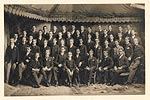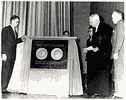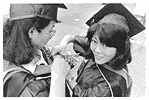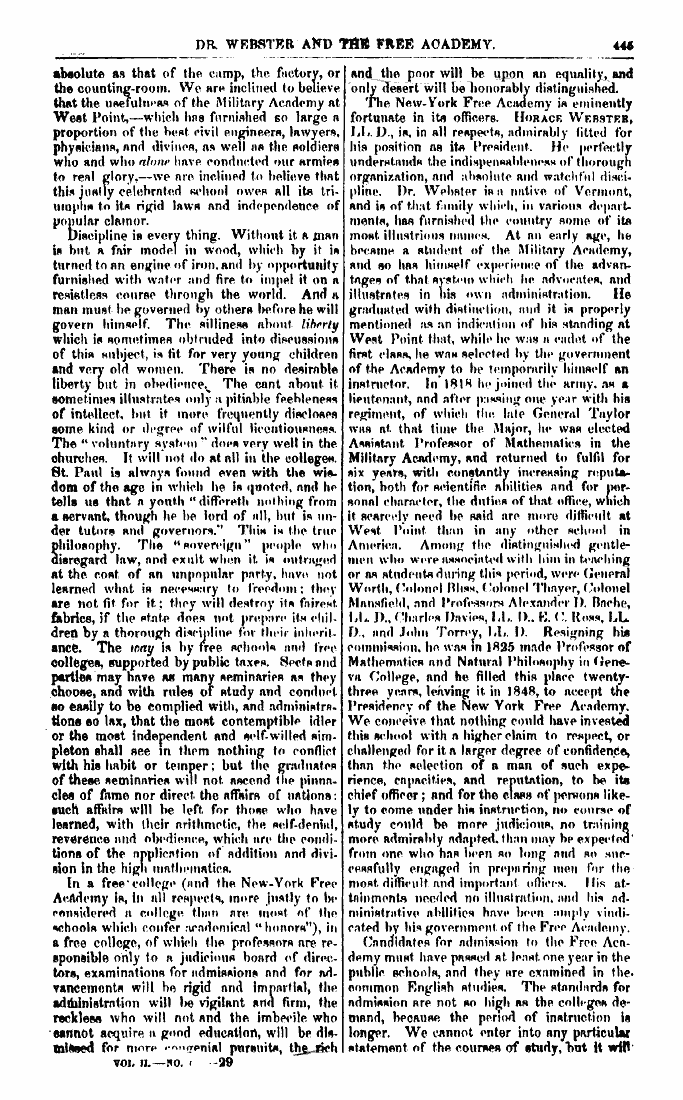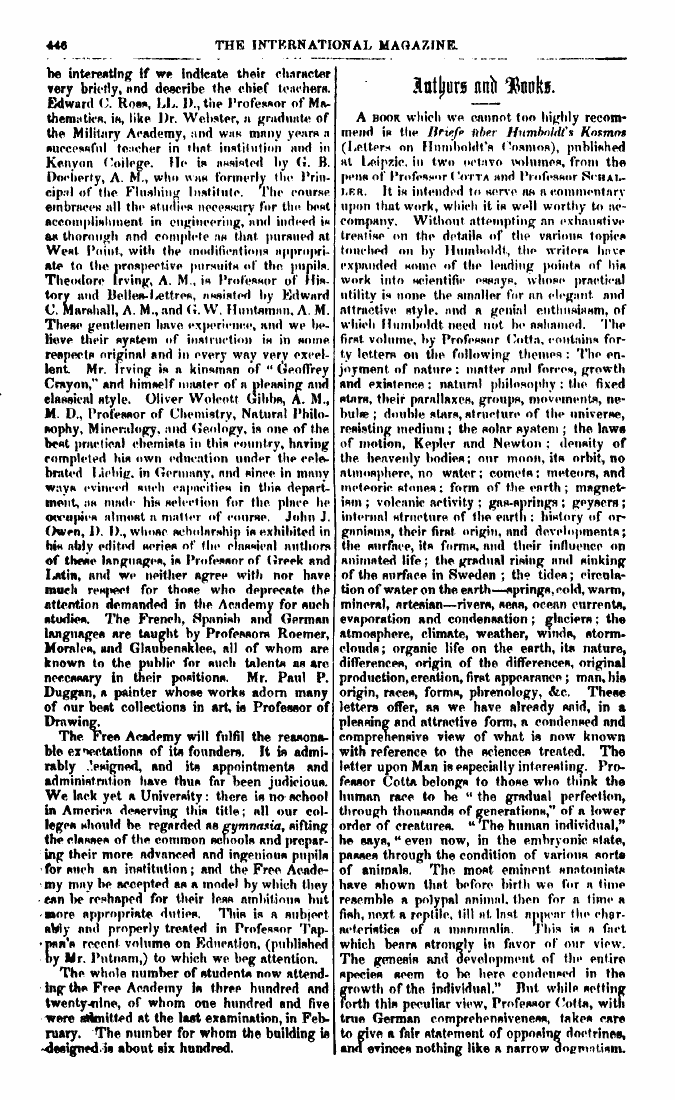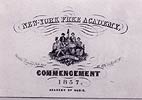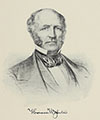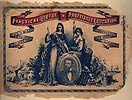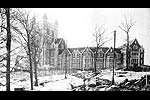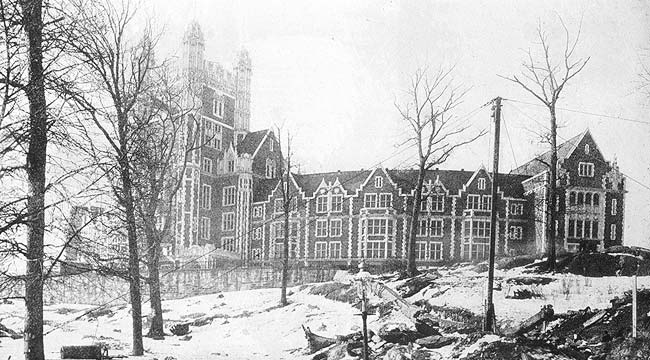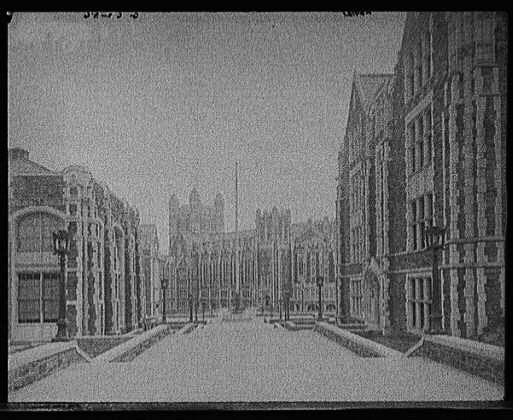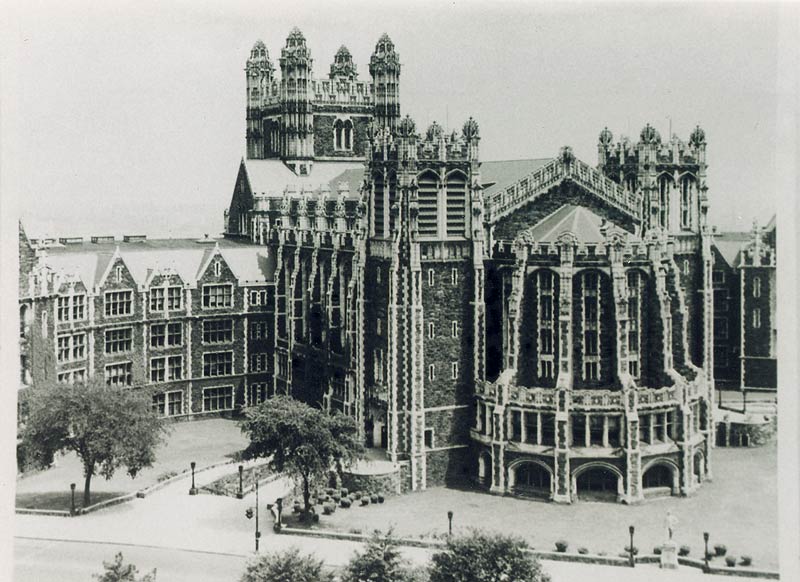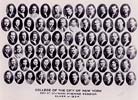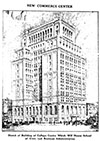History of Baruch College Book and Exhibit
1. BEGINNINGS: FROM FREE ACADEMY TO SCHOOL OF BUSINESS, 1847-1930
"At the end of that remarkable decade [1840s], New York's population had more than doubled to a robust 650,000. Symbolic of the city's size and power was a grand new Merchant's Exchange, completed in 1841 at a cost of nearly $2 million to supply the growing business community with a meeting place. It was a member of that community, merchant Townsend Harris, who first suggested that the growing metropolis of New York needed to invest in free secondary education." [from Berrol, Selma Cantor, Getting Down to Business; chap. 1.] [Source: Making of America project, University of Michigan and Cornell University.]
With the growth of population, both public and private institutions were formed to meet the needs of all its citizens. Of foremost importance was the creation of schools and funding these schools became a source of political controversy. It was the trend towards universal education in the expanding nation that fueled the movement in New York City for institutions of higher learning. The New York State Literature Fund was created to support academies and other private secondary schools. The purpose of the fund was to provide the advantages of advanced education to all young men who could benefit from it, but who could not afford the tuition at New York University or Columbia University. [Source: City College Archives.]
After heated controversy in the press over the establishment of a Free Academy, bills to establish the Academy were introduced into the State Legislature in February of 1847. They eventually were passed in both houses and were signed by Governor John Young on May 7, 1847. [Source: City College Archives.]
Admission to the Free Academy began
with recommendations by grammar school principals and an oral examination
in spelling, reading, writing, grammar, geography, arithmetic and
the history of the United States.
The registers of admission listed the occupations of the students’
fathers, and that of the mother only when she was a widow. The 1851
Admissions Book shows a variety of occupations, which illustrates
the kinds of trades and professions common in nineteenth-century New
York--butcher, gas-fitter, carpenter, laborer, blacksmith and clergyman
were among the occupations listed.
[Source: City College Archives.]
The southeast corner of 23rd Street and Lexington Avenue was selected as the site for the new Free Academy building. The architect James Renwick, Jr. received the commission, and planned the structure with King’s College Chapel at Cambridge, England as his model. The original plan had eighteen classrooms, and a chapel or assembly hall. It had gaslights, drinking fountains and a warm air heating system. The cost of the building was $68,000--$2,000 less than the city allocated for the project! [Source: Making of America project, University of Michigan and Cornell University.]
Horace Webster (1794-1871) was president of the Free Academy from 1849 to 1869. With boys entering the academy as young as fourteen years old, he was determined to maintain decorum among his adolescent charges. As a West Point graduate, he believed in West Point discipline and used the demerit system. He also was an instructor in moral philosophy at the Academy and although he was strict, the students referred to him with affection as "Pop." [Source: Baruch College Archives. The International Magazine of Literature, Science, and Art, volume II, December to March, 1850-51.]
The original Free Academy grew and by 1866 it was renamed the College of the City of New York. Nineteenth-century graduates of the college became leaders in many different professions and Bernard M. Baruch, a 1889 graduate is one of its more notable alumni. Baruch was a financier and economic advisor to American Presidents for over forty years. He always maintained a close relationship to his alma mater, and contributed substantial gifts to the college. The School of Business and Civic Administration of the College of the City of New York was renamed the Bernard M. Baruch School of Business and Public Administration in 1953. In 1968 the college was re-organized and re-named Bernard M. Baruch College and became an independent unit of the City University of New York. [Source: Baruch College Archives.]
The early graduating classes were small, but there were still too many guests attending the commencement to fit into the chapel at 17 Lexington Avenue. At first Niblo’s Garden on Broadway and Prince Street was used for the ceremony, but after 1854 the Academy of Music on the northeast corner of 14th Street and Irving Place took its place. Graduates, parents and guests at the early commencements heard orations from the graduates, and listened to musical selections. When the Academy of Music closed in 1886, commencements were moved to Carnegie Hall where they remained until 1908. [Source: City College Archives.]
Horace Webster was originally from Vermont and received an appointment to West Point where he graduated with the class of 1818. He taught mathematics there until 1826 when he accepted a position as Professor of mathematics and intellectual philosophy at Hobart College, in Geneva New York. In 1849 he came to the new Free Academy where he remained as President for the next twenty years. [Source: City College Archives.]
In 1908 a new campus on St. Nicholas Heights opened, and the original Free Academy building was where late afternoon and evening courses in commerce were offered, in conjunction with the Division of Vocational Subjects. In 1921 the School of Business and Civic Administration was created and accountancy was the foundation of the curriculum. The Accounting Forum succeeded The City College Accountant. [Source: Baruch College Archives. The City College Accountant, June 1918.]
1.11 "Practical, Useful, Profitable Education, Eastman Business College, Poughkeepsie, New York," Front page of catalogue for Eastman Business College (c.1880)
Business education was left to the
private sector in the nineteenth-century with “business colleges”
founded throughout the country. The Eastman Business College in Poughkeepsie,
New York felt they were meeting a new need in the community. "The
past twenty years have developed a deep and growing interest in Business
Education, until at present, all classes accept its necessity."
[Eastman Business College catalogue, n.p.]
The College of the City of New York in 1871 introduced a one-year
commercial course, but because of criticism it was dropped in 1881.
In 1907 the College of the City of New York offered a few business
courses, but it was not until 1919 that the School of Business and
Civic Administration was established, and publicly supported business
education began in New York City.
[Source: Digital Scriptorium project, Duke University.]
1.12 The College of the City of New York, main building, W.138th to W.140th St. and Amsterdam Ave. (c. 1907)
By the end of the nineteenth-century
space became a serious issue and in 1895 the state legislature authorized
funds to purchase property. Forty locations were considered, but in
the end the Board of Trustees chose a two-block parcel between St.
Nicholas Terrace and Convent Avenue from 138th to 140th Streets. Another
parcel of land was added later which extended west to Amsterdam Avenue.
The architect chosen for the project was George B. Post. He designed
a campus of five buildings including the main classroom and administrative
building, the preparatory high school, a gymnasium, the “chemical
building" and a building for the mechanical course. Groundbreaking
was in 1903 and classes began in September 1907.
[Source: American Memory, Library of Congress.]
Evening session programs began at the municipal colleges early in the twentieth-century. Specialized programs in business education were among the first evening session offerings. In 1917 the Division of Vocational Subjects and Civic Administration was formed and it operated in the evening in the building at 17 Lexington Avenue. [Source: Baruch College Archives. Board of Trustees for the College of the City of New York, Proceedings, November 24, 1913; September 27, 1915.]
1.14 "Evening Graduating Class," College of the City of New York, 23rd Street Division Evening Session (1934)
Industrious students often worked during the day, supporting families, and attended classes at night. In 1932, the Board of Education created the new status of "limited matriculants," for those who could not meet the criteria for tuition-free matriculation. They were admitted to the evening session as non-degree students and paid a small fee, until they gained matriculation. [Source: Baruch College Archives.]
Business education slowly gained legitimacy in the United States in the beginning of the twentieth-century. As Governor of New York in 1929, Franklin Roosevelt was a supporter of commercial education, and recognized its importance to society. In this letter the Governor recognized the significance of commercial education and also pleaded for a broad definition of "business." [Source: Baruch College Archives. The Business School Journal, Volume 1, Number 6 (March 1929): 16.]
Advertisements appeared in professional journals for business courses being offered around the country. [Source: Baruch College Archives. The Business School Journal, Volume 1, Number 2 (November 1928): 41.]
It was a noteworthy occasion when the cornerstone was laid for the School of Business and Civic Administration. New York's Mayor Jimmy Walker was present and pledged his support. At that time more money was needed to extend the structure from its original plan for eight stories to sixteen stories. Mayor Walker stated:
"I have come to pledge you all the support the mayor can give in making this the greatest institution of learning in the world...I know of no more conservative investment than the extra $900,000 needed to complete this sixteen story building." [Source: City College Archives. The Campus, December 6, 1928. "Cornerstone of New Building Cemented by Mayor Walker as Civic Dignitaries Look On."]
The School of Business and Civic Administration opened in 1919 in the antiquated original Free Academy building. The facility was deemed dangerous and after some minor violations were corrected the building continued to be used until 1926. A new eight-story building was planned, but the Board of Trustees and the President of the college believed that a sixteen story building was more appropriate. The first eight floors were completed in September 1929 and the remaining floors were finished in 1930. [Source: Baruch College Archives.]
The impressive new building of the School of Business and Civic Administration received much favorable attention. It was noted in the caption of this picture that it "is the largest structure anywhere devoted to the teaching of business methods and practice." [Source: Baruch College Archives. The Journal of Business Education, Volume 2, Number 6 (September 1929): 14.]
